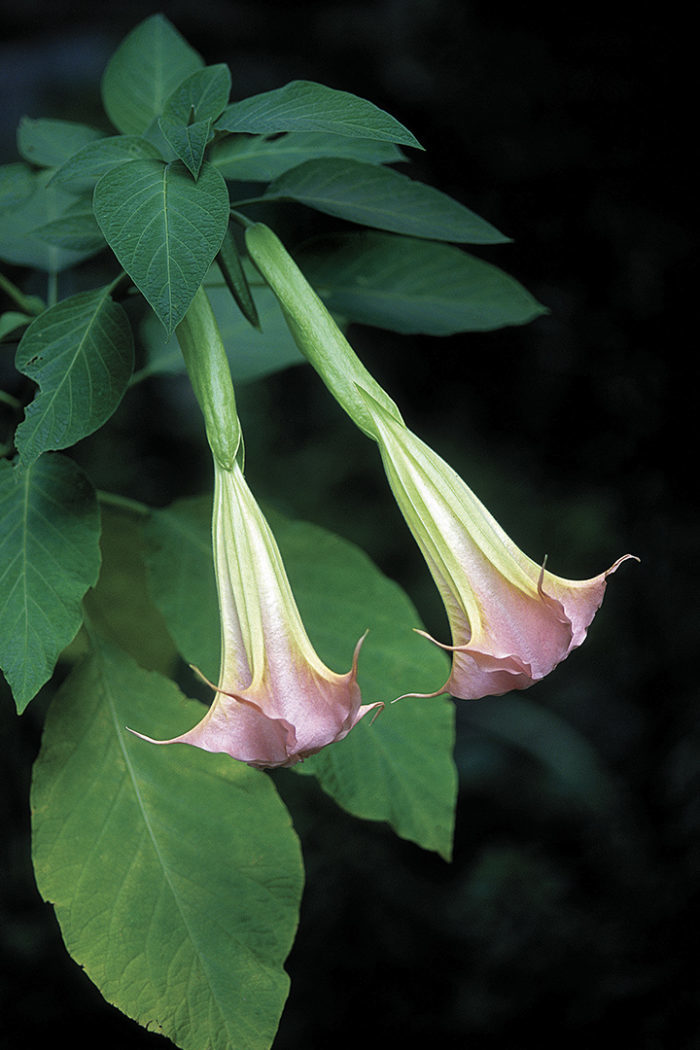
What could have more wow factor than a 6- to 10-foot-tall shrub smothered with luminous, 12-inch-long, hanging, bell-shaped flowers that are wonderfully fragrant in the morning and evening? Angels’ trumpets (Brugmansia spp. and cvs., USDA Hardiness Zones 9–11) are spectacular garden focal points. And even though they aren’t hardy in temperate climates, they’re easy to overwinter, getting bigger and better each year.
Of the hundreds of varieties to choose from, all have flowers in shades of peach, pink, yellow, orange, or white. Angels’ trumpets are fast-growing beauties. And as you’d suspect with something that can add 4 to 5 feet or more of new growth in a season, they require plenty of food and water. As soon as their roots warm up in spring and they are potted up in their summer containers, they put out growth at an amazing rate. It’s almost as much fun to watch new branches shoot up as it is to see them push out their amazing flowers. These enormous plants have to come inside for winter, so I can only accommodate a few. Here are seven of my top choices.
The Earliest Trumpets of the Season
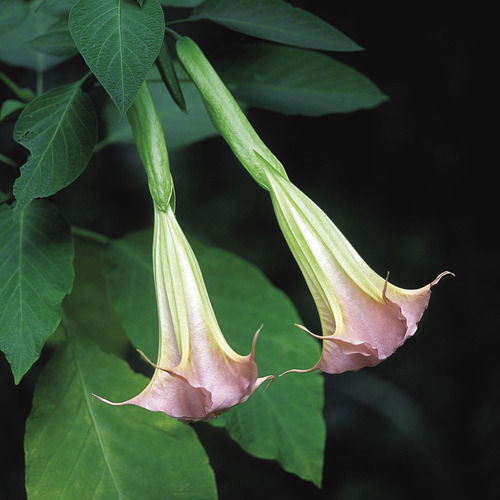
Are you a fan of pale pink? Then ‘Frosty Pink’ angels’ trumpets (Brugmansia ‘Frosty Pink’) is a great choice for you. Many think it’s the fastest-growing and easiest angels’ trumpets to grow. This vigorous plant is one of the earliest to come into bloom in early summer, sporting 12- to 15-inch-long buds that emerge yellow and gradually mature to soft pinkish white with darker pink at the flared edges. I’ve grown this plant to an 8-foot-tall specimen in a 28-inch-diameter container in just two seasons.
Fewer Flowers but More Pizzazz

If you’d like to grow something a bit more exotic, how about ‘Double White’ angels’ trumpets (Brugmansia candida ‘Double White’)? In a container here in the Northeast, this variety stays shorter than some of the others I grow, topping out at 6 to 7 feet tall. In my garden, this plant doesn’t produce the masses of flowers that others do, but the flowers are so gorgeous that I don’t mind. The funnel-shaped blossom has another funnel peeking out of it, and the entire bloom can be 16 to 18 inches long. The flowers last longer if I grow the plant in a bit less sun than the other varieties. This plant makes a great addition to a patio area, where the intricate double blooms can be admired up close.
Pink Blooms that Prefer Warmth and Shade
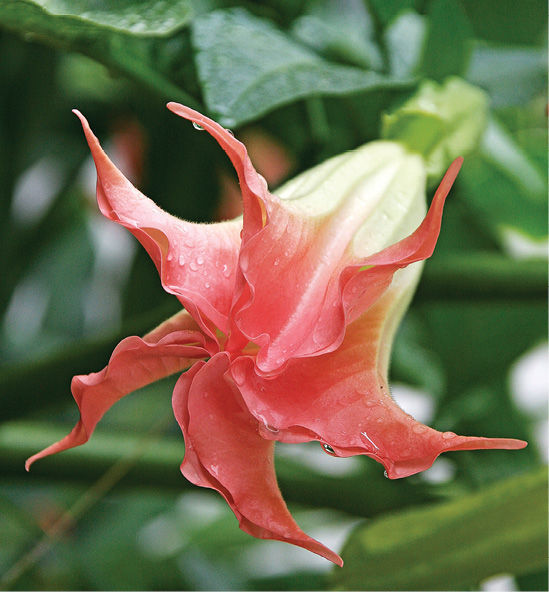
A great pink variety is the appropriately named ‘Pink’ angels’ trumpets (Brugmansia insignis ‘Pink’), which can grow from 8 to 10 feet tall when mature. The nodding flowers, which are a lovely pale pink that ages to a darker pink, are 12 inches long and 9 inches wide and, like all angels’ trumpets, are heavily fragrant in the evening. This plant blooms best in a warm summer, when it will bloom almost nonstop. It does a bit better when grown in some afternoon shade as its delicate flowers tend to wilt in the heat of the midday sun.
A Popular Giant with Two Bloom Periods
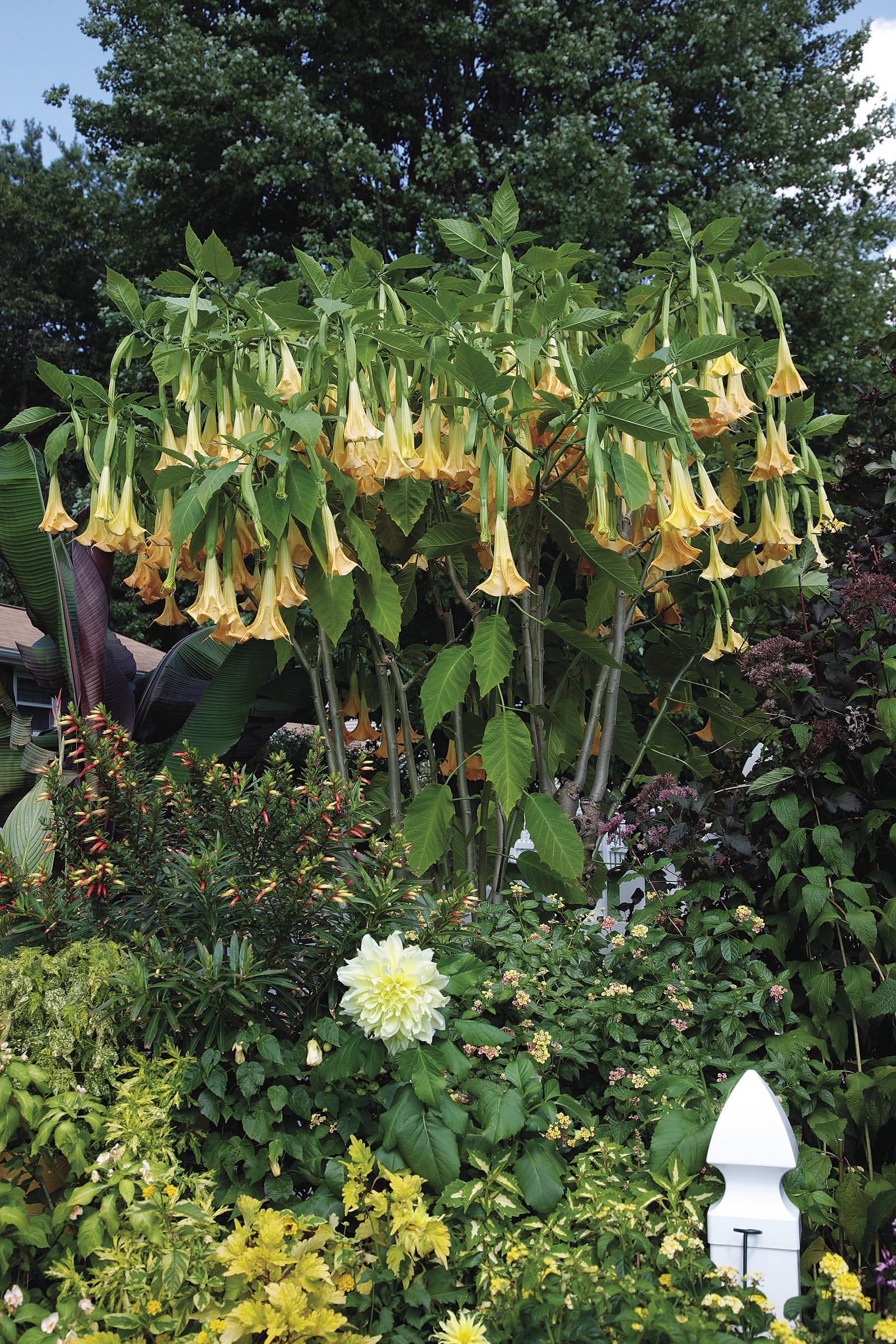
At the top of my list of favorites is ‘Charles Grimaldi’ angels’ trumpets (Brugmansia cubensis ‘Charles Grimaldi’). This variety can grow into an enormous specimen—even in a container, where it can reach up to 9 feet tall and wide by the end of the season. It produces very large flowers, which emerge a pale yellow, then deepen to a rich, golden peachy yellow at maturity. ‘Charles Grimaldi’ is not the earliest bloomer, usually having its first flush of blooms by midsummer. After a brief rest, it gets ready for its second bloom set in late summer, when it can have 300 or more blossoms open at the same time. You might find that your plant decides to bloom continually, and during a warm fall, it may have a third flush of flowers. The visual appeal of a 9-foot-tall tree smothered with hundreds of perfumed golden blossoms makes it worth the time and effort to grow this beauty. I grow mine in a 32-inch-diameter pot at the front corner of our property in view of passersby, and I invariably have folks stop to ask about this extraordinary plant.
White-Splashed Leaves and Lovely Peach Blossoms

One of my current favorites is ‘Maya’ angels’ trumpets (Brugmansia candida ‘Maya’). In my garden, this large, beautiful plant is 8 feet tall at the end of its third season in a 28-inch-diameter container. It has beautiful variegated leaves, which complement the 14-inch-long, soft peach flowers. This is another heavy blossom producer: I counted more than 300 flowers during its second flush in the summer of 2011. It’s also heavily fragrant, and when in bloom, it perfumes the entire garden in the evenings. I grow this variety in a container border filled with tropicals, and it is a great focal plant for the collection around it.
A Compact Plant that Blooms in Waves
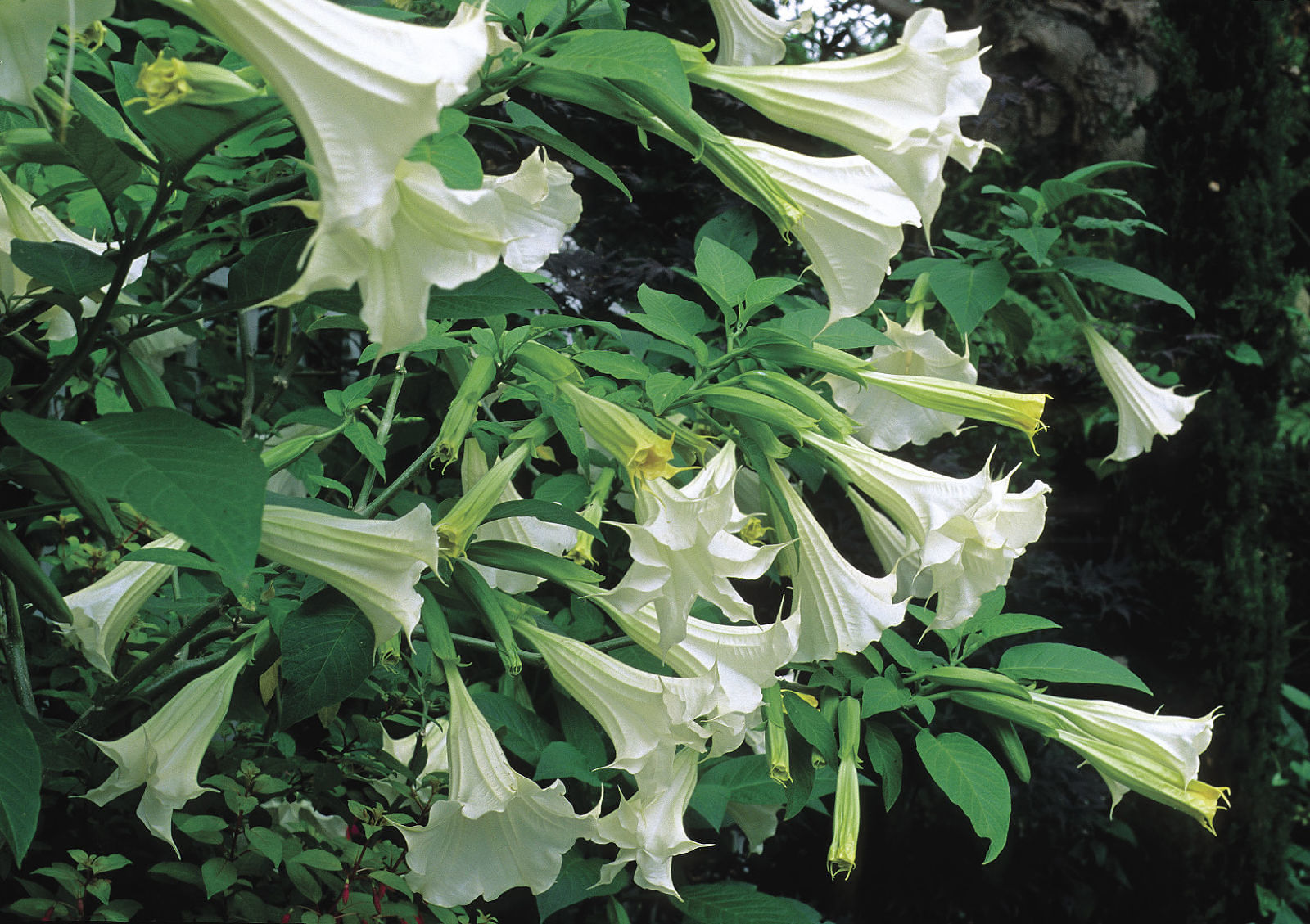
For early and profuse blooms with short intervals between flushes, nothing in my collection compares to my Brugmansia suaveolens (white form). This plant makes a dense shrub and stays shorter than my other angels’ trumpets, becoming wider than it is tall by the end of summer. It’s early to branch out and form buds, which emerge green and gradually mature into glistening, 12- to 13-inch-long, pristine white blossoms. This plant can carry more than 200 flowers at a time in a 24-inch-diameter container, and normally opens its first flowers by early summer. It will sporadically bloom until its second flush of blooms in midsummer.
A Bolder Punch of Tropical Color
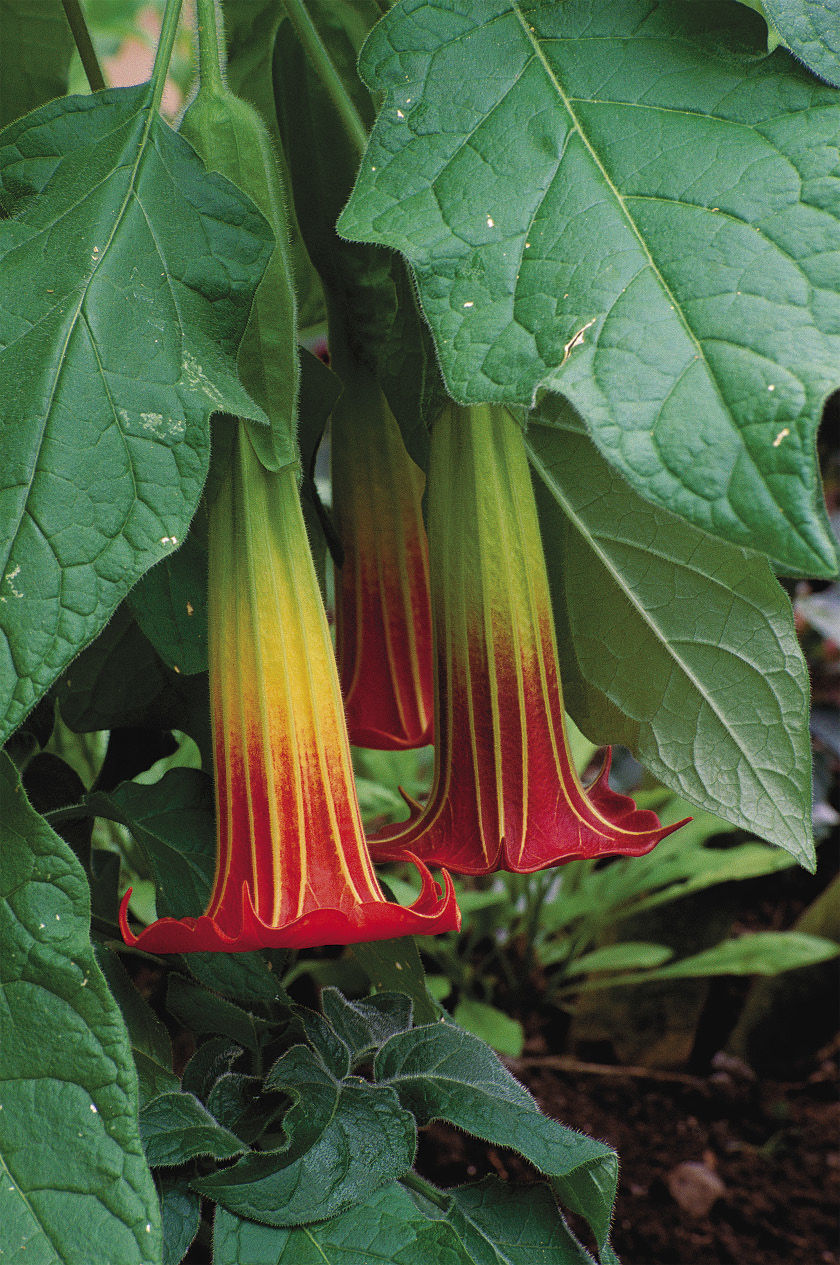
If you are a gardener who loves intense colors, then you will love Brugmansia sanguinea. This lesser-known species has 6- to 10-inch-long flowers that don’t flare as much as most varieties. The tube-shaped corollas are usually a greenish yellow with hot red to red-orange mouths. The plant is somewhat less free-flowering than other varieties and objects to hot summer temperatures, but it does well in the cooler weather of late summer and autumn. It’s also tolerant of cold and light frosts as it comes from the Andes and is found at elevations between 6,000 and 9,000 feet.
❮❮❮ If you like angels’ trumpets . . .
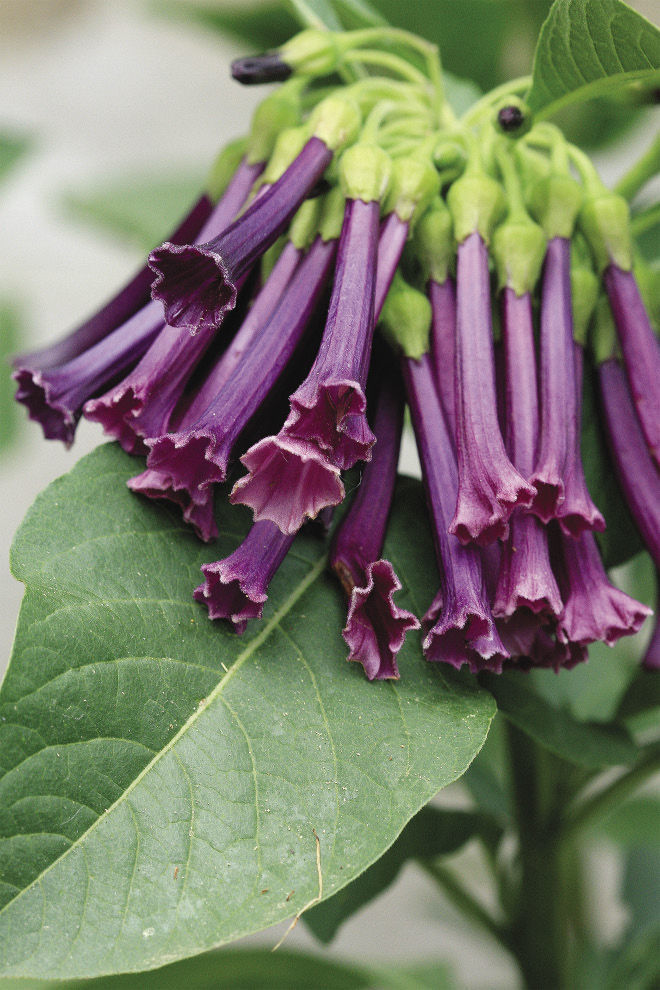
Then try growing iochroma (Iochroma cyaneum, Zone 11). This plant is now all the rage in nurseries. It’s closely related to angels’ trumpets, and its care is exactly the same. The purple flowers are 3 to 4 inches long and bloom in clusters at the end of the branches. The flowers are smaller than those of angels’ trumpets, but what they lack in size, they make up for in abundance. Like angels’ trumpets, the plants are fast growers and can top out at up to 5 feet tall in a season. My three-year-old mature specimen has reached a wonderful size of 8 feet tall and 4 feet wide, and is smothered with flowers that are hummingbird magnets. What’s not to love?
A Year in the Life of an Angels’ Trumpets
Of all the container plants I grow, none requires as much water and fertilizer as an angels’ trumpets. But it’s truly worth the extra effort as it makes the difference between having a nice-looking plant and having a huge, spectacular specimen covered with hundreds of flowers. Here’s what to do throughout the year to get the most out of your plant:
Spring – When purchasing a new angels’ trumpets, look for a plant that doesn’t have yellowed leaves as this can indicate stress. Check the underside of the leaves for faint webbing, small spots, and yellowing, which could indicate an infestation of spider mites. The bigger the plant is, the more likely you’ll have lots of flowers the first season—so buy the largest plant you can afford. Pot up the plant in a large, sturdy container, and feed it weekly with an all-purpose liquid fertilizer, strictly following the manufacturer’s directions. Water often when the soil is slightly damp or just dry to the touch.
Summer – By late spring, the plant should be actively growing and you can increase the feeding to twice a week. If the plant shows yellowing leaves, then that indicates it needs a bit more food. Water daily; by midsummer and during spells of hot weather, the plant may need extra watering by late afternoon. Look out for spider mites and aphids. With spider mites, the leaves will yellow and look pitted, and you may find fine webbing on the leaf underside. Aphids will leave a sticky residue on the leaves. I treat both with Bayer 3-in-1 Insect, Disease, & Mite Control or with neem oil.
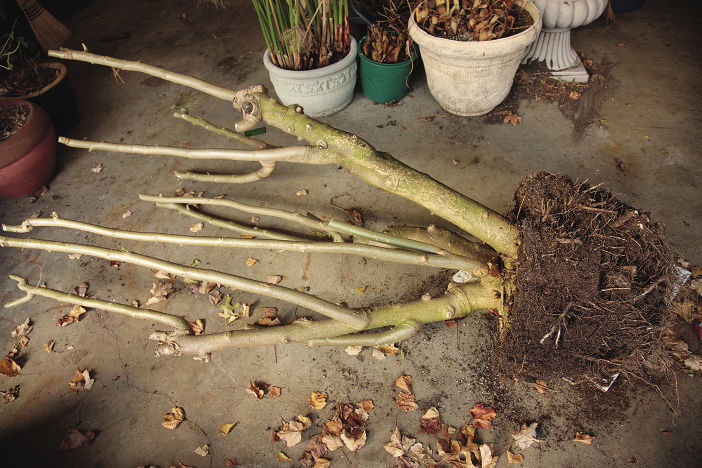
Early fall – Discontinue feeding, but continue to water daily. When the days start to cool significantly, prune the plant back by half, remove all its leaves, and dig it out of its pot. Place the root-ball in a black plastic trash bag, and move the plant indoors to a warm garage or cool basement, preferably where it’s dark and about 50°F.
Late Fall – The plant is dormant and needs no attention at this time.
Winter – Once a month, check to see if the plant needs water. If the soil is dry to the touch, then water sparingly.
Late Winter – Continue checking once a month to see if the plant needs any water. Toward the beginning of spring, bring the plant into a frost-free area, like a garage, where it can get some sunlight and start coming out of dormancy. Pot it up in a temporary plastic container. Water sparingly until you see active growth and greening up.
Early Spring – Continue to water sparingly but only when the soil is almost dry to the touch.
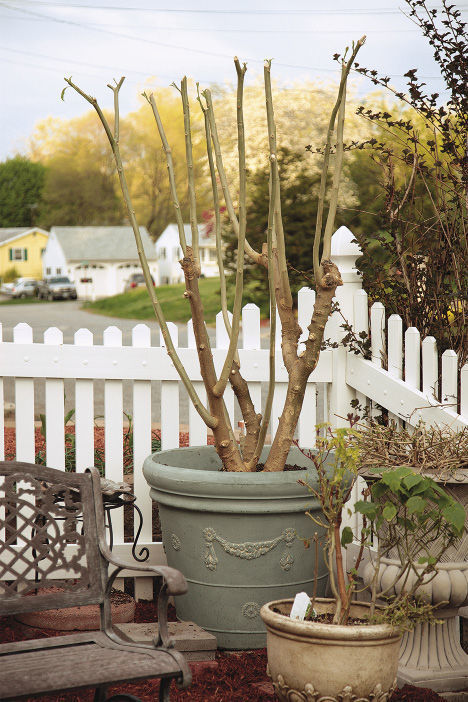
Deanne Fortnam is a fine artist and avid gardener who tends hundreds of containers in her Nashua, New Hampshire, garden.
Photos, except where noted: Deanne Fortnam; Bill Johnson; www.millettephotomedia.com; Joshua McCullough/www.phytophoto.com; Marcus Harpur/www.gapphotos.com; John Glover/www.gapphotos.com
Sources
The following mail-order plant sellers offer the widest selection of the angels’ trumpets featured:
• Annie’s Annuals & Perennials, Richmond, Calif.; 888-266-4370; www.anniesannuals.com
• Glasshouse Works, Stewart, Ohio; 740-662-2142; www.glasshouseworks.com
• Kartuz Greenhouses, Vista, Calif.; 760-941-3613; www.kartuz.com
• Logee’s Greenhouses, Danielson, Conn.; 888-330-8038; www.logees.com
• Maranatha Nursery, Winnsboro, Tex.; 903-857-2300; www.angelswithleaves.com

















Comments
Log in or create an account to post a comment.
Sign up Log in